Enhanced Real-Time Simulation of ROV Attitude and Trajectory Under Ocean Current and Wake Disturbances
Abstract
1. Introduction
2. Extension and Refinement of the Ocean Disturbance Simulation System Model
2.1. Theoretical Basis
- 1.
- Kinetics Module
- 2.
- Kinematics Module
- 3.
- Controller Module
- 4.
- Allocation Module
- 5.
- Thruster Module
- Inertia matrix M
- Coriolis moment matrix C(v)
- Damping matrix D(ν)
- Gravity and buoyancy matrix G(η)
2.2. Method Analyses
- The non-wake flow area corresponded to ω ∈ [−45°, +45°], where the ROV approached from the front without entering the wake region;
- Wake flow area 1 covered the angular range ω ∈ (45°, 135°) ∪ (225°, −45°), where the ROV encountered lateral wake effects;
2.3. Building the Ocean Current Disturbance Module
- Non-wake flow area: V = Vcurrent;
- Wake flow area 1: V = Vcurrent + Vwake, that is:
- Wake flow area 2: V = Vcurrent − Vwake, which means:
- Non-wake flow area (ω ∈ [−45°, +45°]): When the ROV moved approximately in the same direction as the ocean current, approaching from the front without entering the wake region, Equation (11) was applied;
- Wake flow area 1: (ω ∈ (45°, 135°) ∪ (−135°, −45°)): When the ROV experienced lateral wake interference due to side-on current interaction, Equation (13) was used;
- Wake flow area 2: (ω ∈ [135°, 225°]): When the ROV moved directly against the current, entering the downstream wake region behind the target, Equation (14) was employed.
3. Experimental Materials
4. Experimental Results
4.1. When the ROV Is Facing Directly Toward the Current
4.2. When the ROV Is Side-On to the Current
4.3. The ROV Is Facing Away from the Current
5. Comparison Between the Proposed Model and Current Mainstream Models
6. Discussion and Future Work
- (1)
- The control structure is based on a traditional PID controller, which, although widely used in marine systems, does not adapt to environmental variations or uncertainties.
- (2)
- The environmental model assumes quasi-steady ocean currents and simplified wake interference, which may not fully capture real-world turbulence or chaotic fluctuations.
- (3)
- The simulation does not incorporate external feedback loops, real-time sensor data, or actuator dynamics.
- (4)
- The study is limited to a single-ROV scenario and does not account for distributed cooperation or inter-ROV interference.
7. Conclusions
Author Contributions
Funding
Data Availability Statement
Conflicts of Interest
References
- Amundsen, H.B.; Caharija, W.; Pettersen, K.Y. Autonomous ROV Inspections of Aquaculture Net Pens Using DVL. IEEE J. Ocean. Eng. 2022, 47, 1–19. [Google Scholar] [CrossRef]
- Bartlett, B.; Trslic, P.; Santos, M.; Penica, M.; Riordan, J.; Dooly, G. Dynamic Positioning System for low-cost ROV. In Proceedings of the OCEANS 2023—Limerick, Limerick, Ireland, 5–8 June 2023; pp. 1–5. [Google Scholar]
- Zhao, J.; Xu, Y.; Lei, L. Establishment of a simulator for intelligent path planning of underwater robots. J. Syst. Simul. 2004, 11, 2448–2450. [Google Scholar]
- Xu, L.; Bian, Y.; Zong, G. Path Control and Simulation of Underwater Robots. J. Beihang Univ. 2005, 2, 162–166. [Google Scholar]
- Ren, C.; Wan, N.; Wang, S.; Wang, D. Research on Optimal Path Planning Problem for Autonomous Underwater Robots. China Navig. 2003, 9, 14–18. [Google Scholar]
- Li, Y.; He, J.; Jiang, Y.; An, L. Semi physical simulation of AUV return and seated docking. Robotics 2017, 39, 119–128. [Google Scholar]
- Gabl, R.; Davey, T.; Cao, Y.; Li, Q.; Li, B.; Walker, K.L.; Giorgio-Serchi, F.; Aracri, S.; Kiprakis, A.; Stokes, A.A.; et al. Hydrodynamic loads on a restrained ROV under waves and current. Ocean. Eng. 2021, 234, 109279. [Google Scholar] [CrossRef]
- Rostamzadeh-Renani, M.; Rostamzadeh-Renani, R.; Baghoolizadeh, M.; Azarkhavarani, N.K. The effect of vortex generators on the hydrodynamic performance of a submarine at a high angle of attack using a multi-objective optimization and computational fluid dynamics. Ocean. Eng. 2023, 282, 114932. [Google Scholar] [CrossRef]
- Rostamzadeh-Renani, M.; Baghoolizadeh, M.; Sajadi, S.M.; Rostamzadeh-Renani, R.; Azarkhavarani, N.K.; Salahshour, S.; Toghraie, D. A multi-objective and CFD based optimization of roof-flap geometry and position for simultaneous drag and lift reduction. Propuls. Power Res. 2024, 13, 26–45. [Google Scholar] [CrossRef]
- Liu, P.; Tian, L.; Qiu, T.; Li, L.; Huang, F.; Yin, B.; Zhu, G. Optimization simulation of ROV controller parameters based on combinatorial optimization algorithm. Mar. Eng. Equip. Technol. 2023, 10, 64–70. [Google Scholar]
- Long, C.; Qin, X.; Bian, Y.; Xu, B.; Hu, M. Trajectory tracking control of an ROV using model predictive control considering external disturbances. In Proceedings of the 2021 5th CAA International Conference on Vehicular Control and Intelligence (CVCI), Tianjin, China, 29–31 October 2021; pp. 1–5. [Google Scholar]
- Lack, S.; Rentzow, E.; Jeinsch, T. Trajectory generation for a quaternion based 6-DoF ROV tracking controller. In Proceedings of the 2022 30th Mediterranean Conference on Control and Automation (MED), Vouliagmeni, Greece, 28 June–1 July 2022; pp. 414–419. [Google Scholar]
- Daddi, A.S.; Gundewar, P.P.; Mulay, G. MIMO Model Development of the Navigational System of an Underwater ROV. In Proceedings of the 2022 International Conference for Advancement in Technology (ICONAT), Goa, India, 21–22 January 2022; pp. 1–7. [Google Scholar]
- Huang, H.; Wan, L.; Pang, Y.; Qin, Z.; Zeng, W. Research on fault-tolerant control of SY-II remote-controlled underwater robot thruster. J. Appl. Basic Eng. Sci. 2012, 20, 1118–1128. [Google Scholar]
- Mulero-Martínez, J.I. A new factorization of the Coriolis/centripetal matrix. Robotica 2009, 27, 689–700. [Google Scholar] [CrossRef]
- Fossen, T.I. Fossen’s Marine Craft Model. Wikipedia. 2002. Available online: https://www.fossen.biz/html/marineCraftModel.html (accessed on 27 February 2025).
- Fossen, T.I. Handbook of Marine Craft Hydrodynamics and Motion Control; Wiley: Hoboken, NJ, USA, 2011. [Google Scholar]
- Hosseinnajad, A.; Loueipour, M. Design of a Robust Observer-based DP Control System for an ROV with Unknown Dynamics Including Thruster Allocation. In Proceedings of the 2021 7th International Conference on Control, Instrumentation and Automation (ICCIA), Tabriz, Iran, 23–24 February 2021; pp. 1–6. [Google Scholar]
- Zhao, M.; Chen, Y.; Jiang, J. Hydrodynamics and Wake Flow Analysis of a Floating Twin-Rotor Horizontal Axis Tidal Current Turbine in Roll Motion. J. Mar. Sci. Eng. 2023, 11, 1615. [Google Scholar] [CrossRef]
- Det Norske Veritas. DNV-RP-C205: Environmental Conditions and Environmental Loads; DNV: Høvik, Norway, 2010. [Google Scholar]
- Brandt, A.; Sebben, S.; Jacobson, B. Base wake dynamics and its influence on driving stability of passenger vehicles in crosswind. J. Wind. Eng. Ind. Aerodyn. 2022, 230, 105164. [Google Scholar] [CrossRef]
- Fossen, T.I. Guidance and Control of Ocean Vehicles; John Wiley & Sons: Chichester, UK, 1994. [Google Scholar]
- Prestero, T. Verification of a Six-Degree of Freedom Simulation Model for the REMUS Autonomous Underwater Vehicle; MIT/WHOI Joint Program: Cambridge, MA, USA, 2001. [Google Scholar]
- Sun, G.; Su, Y.; Mao, Y.; Xie, J.; Jiao, H.; Qv, J. Multi level thrust allocation strategy for hybrid propulsion ROV based on fuzzy logic. Robot 2023, 45, 472–482. [Google Scholar]
- Liu, S.; Deng, Z.; Sun, J.; Ding, L. Introduction to the Drawing Function of MATLAB Software. Comput. Learn. 2000, 3, 49. [Google Scholar]
- Zou, Y.; Tao, Z.; Li, X. Research on Attitude Control of Underwater Robots Based on Active Disturbance Rejection Controller. Chem. Autom. Instrum. 2024, 51, 621–630. [Google Scholar]
- Xue, Y.; Wang, S.; Ma, W.; Zeng, Z. Underwater Wall-Climbing Inspection ROV Scheme Design and Flow Resistance Simulation Based on BlueROV2 Modification. In Proceedings of the 2023 IEEE 3rd International Conference on Software Engineering and Artificial Intelligence (SEAI), Xiamen, China, 16–18 June 2023; pp. 215–219. [Google Scholar]
- Yao, X.L.; Wang, F.; Wang, J.F.; Wang, X. A method for optimal energy consumption path planning of AUV under time-varying ocean flow field. Control Decis. 2020, 35, 2424–2432. [Google Scholar]
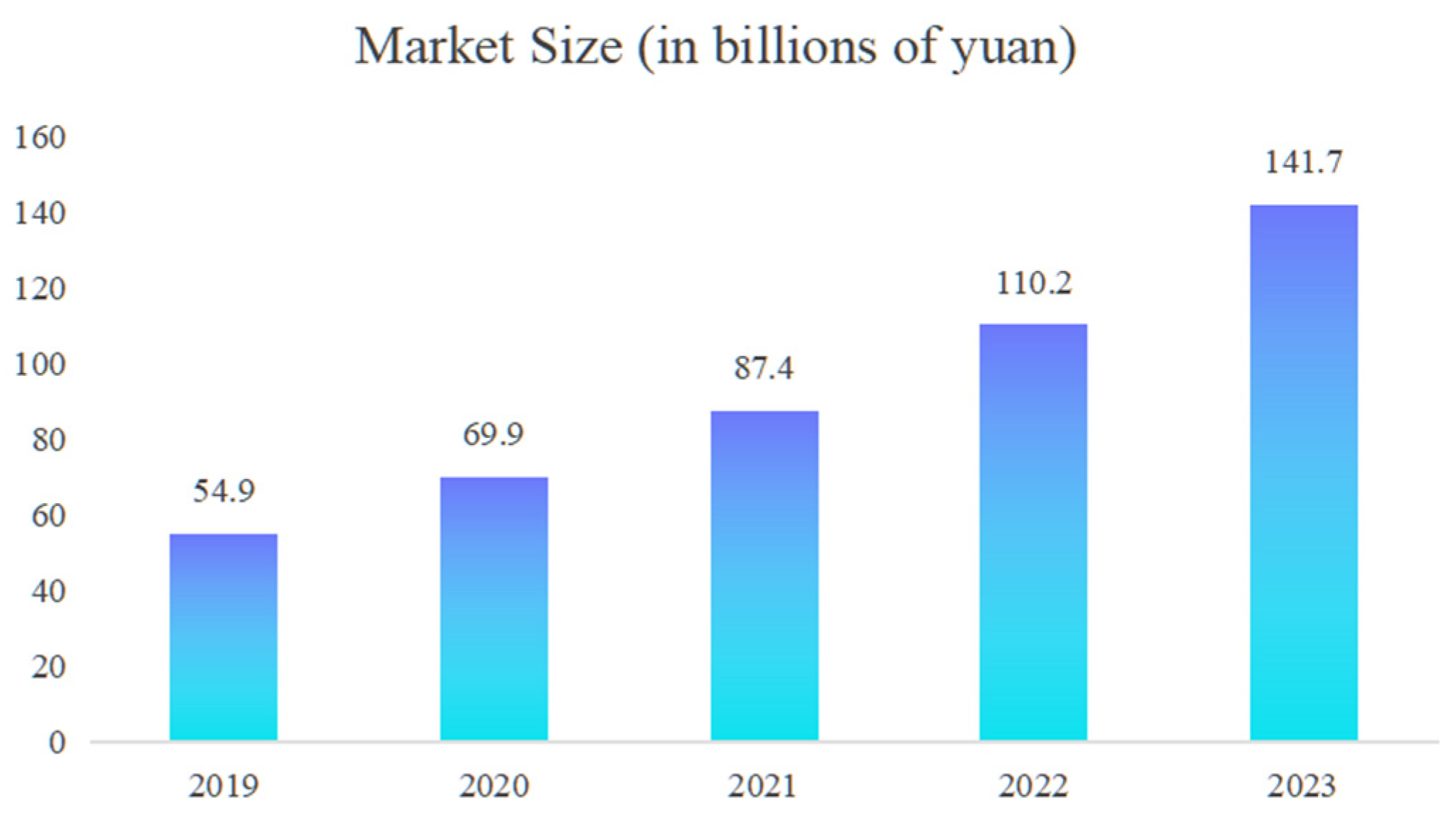
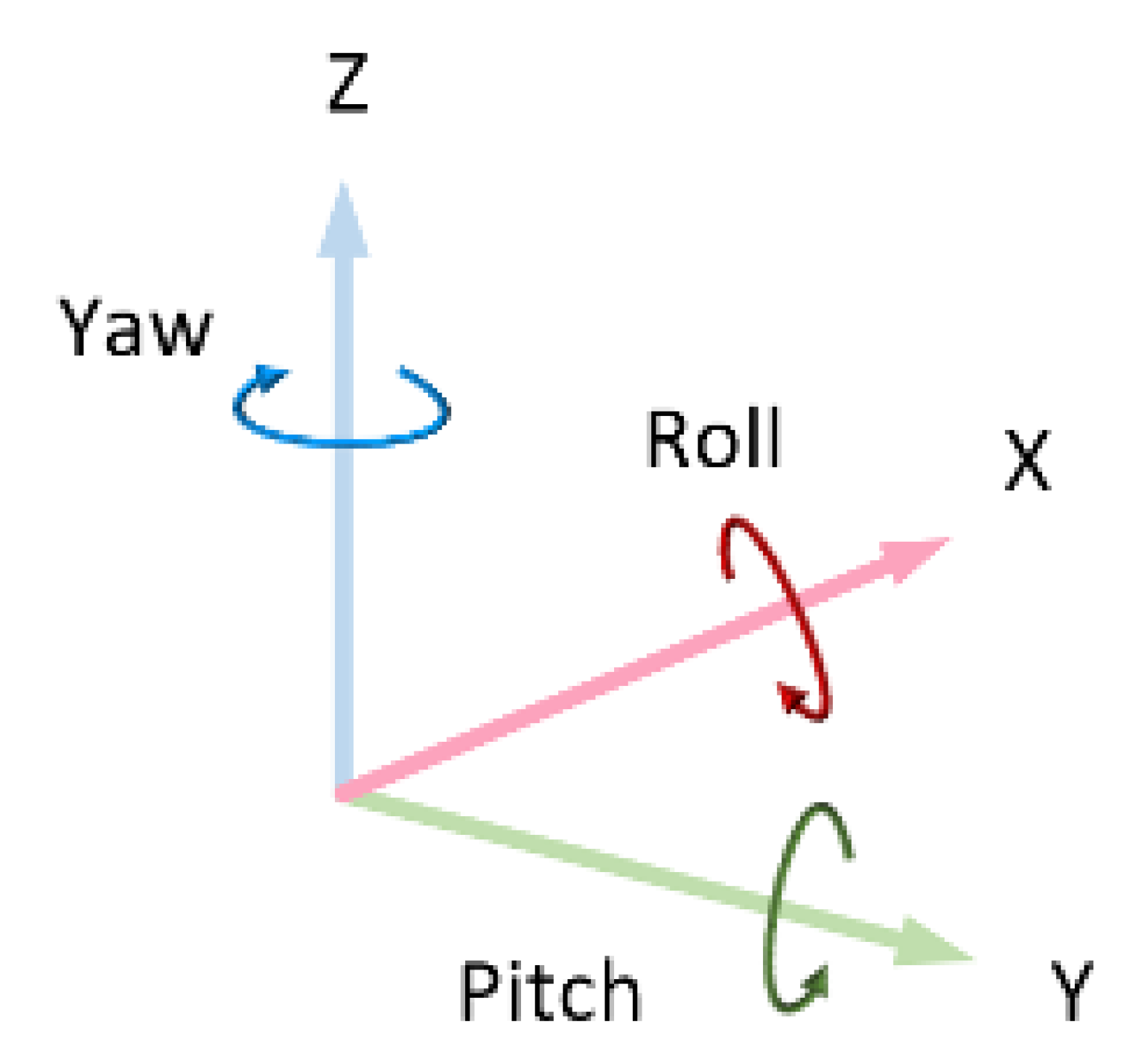
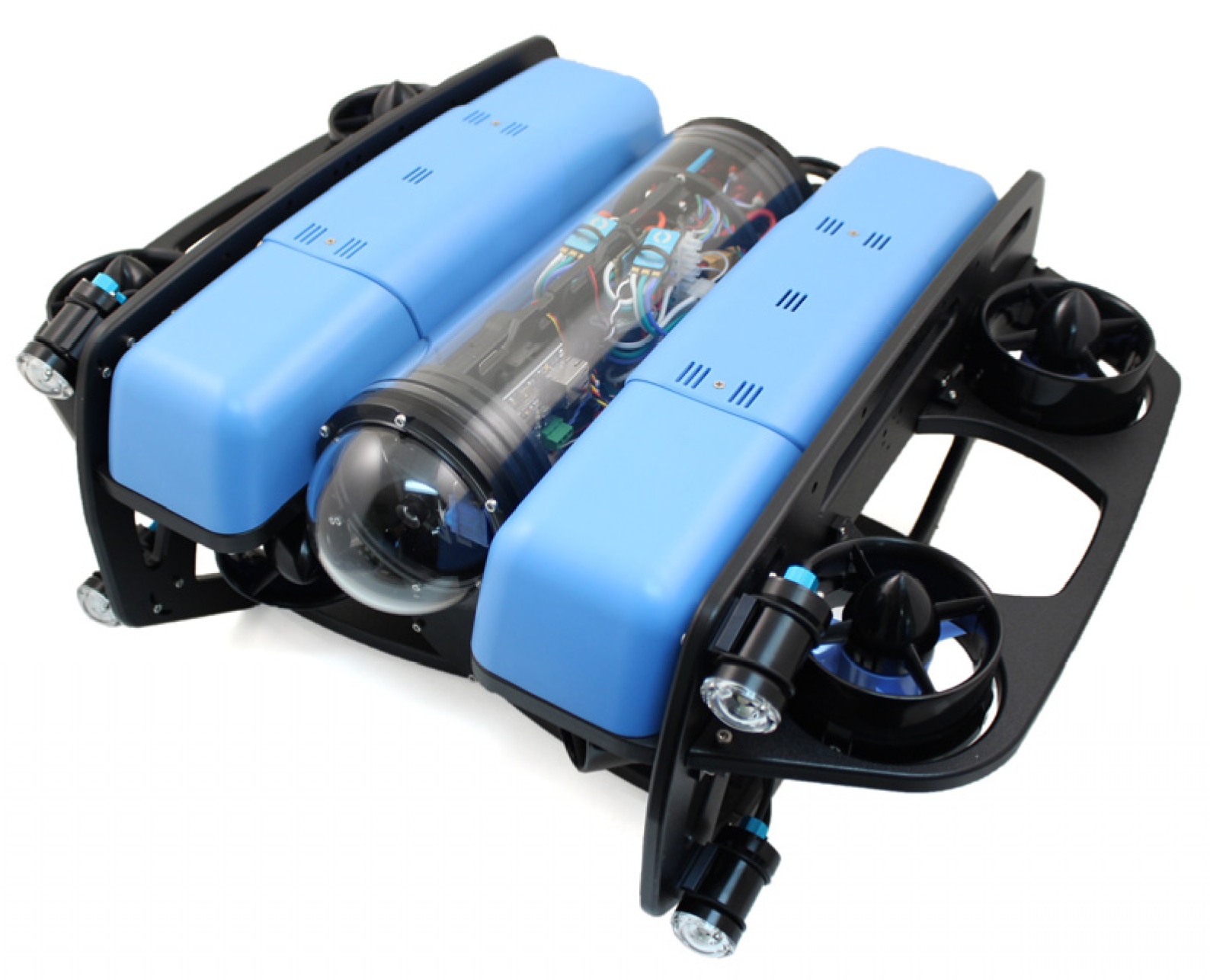

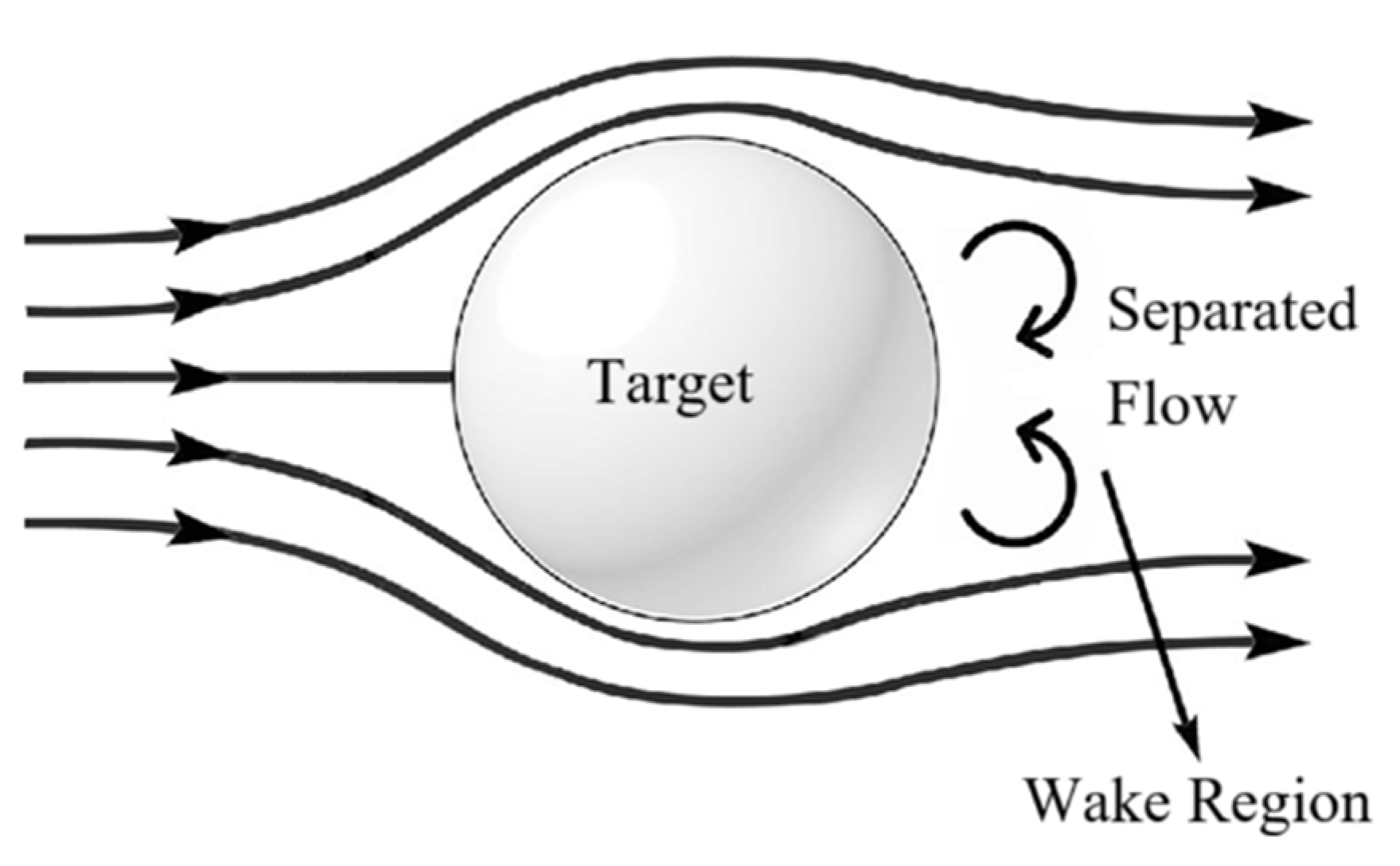
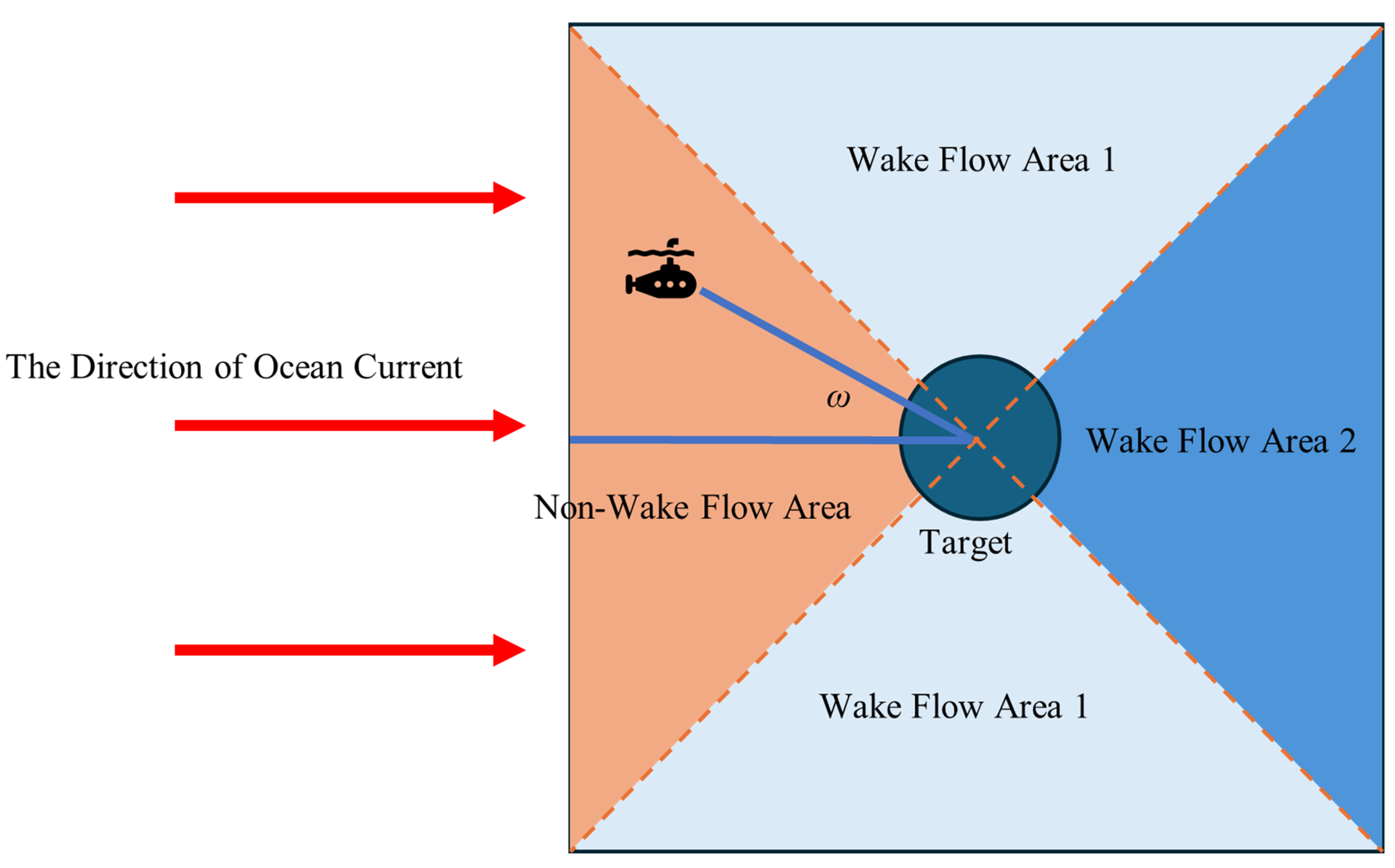
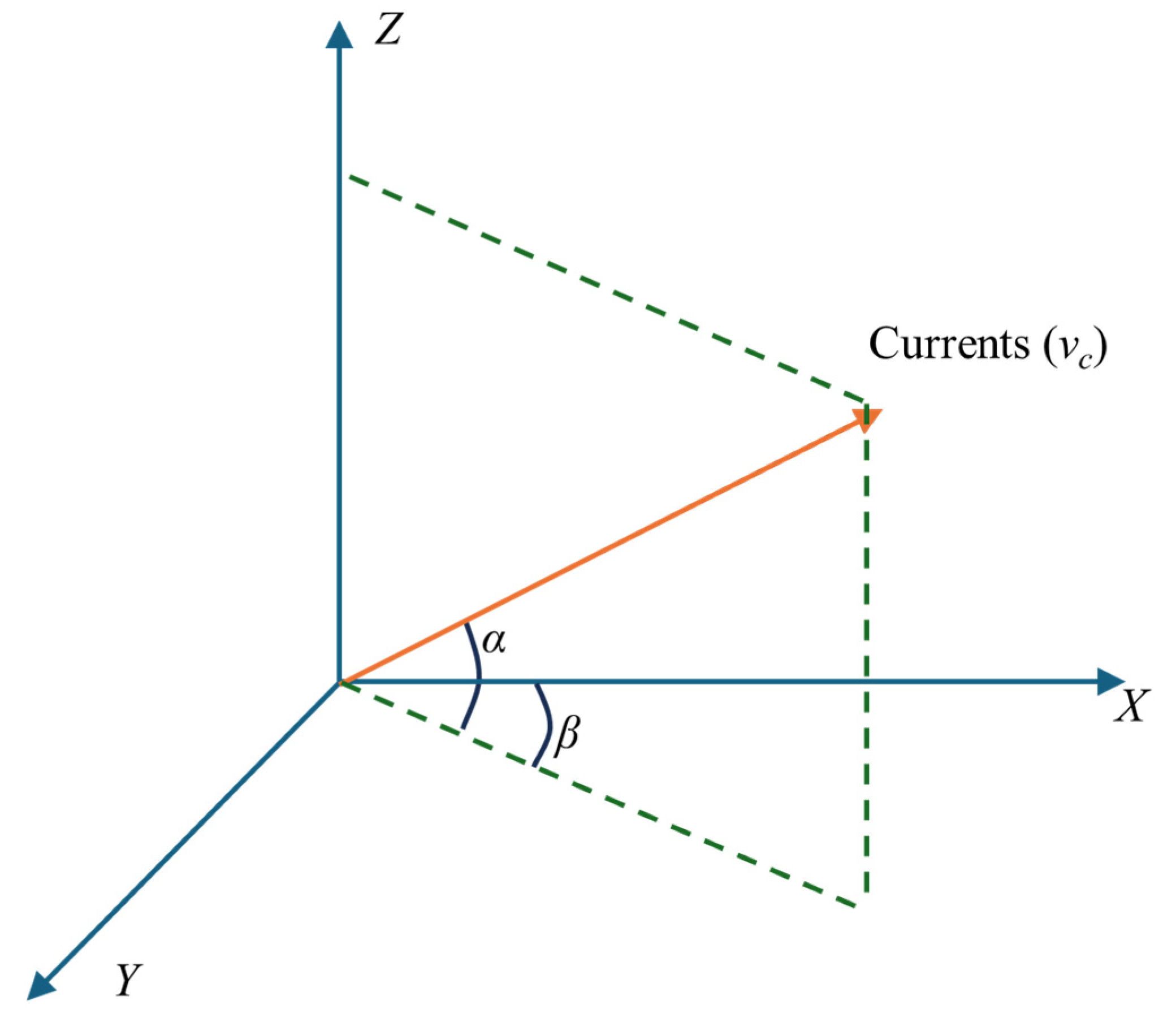
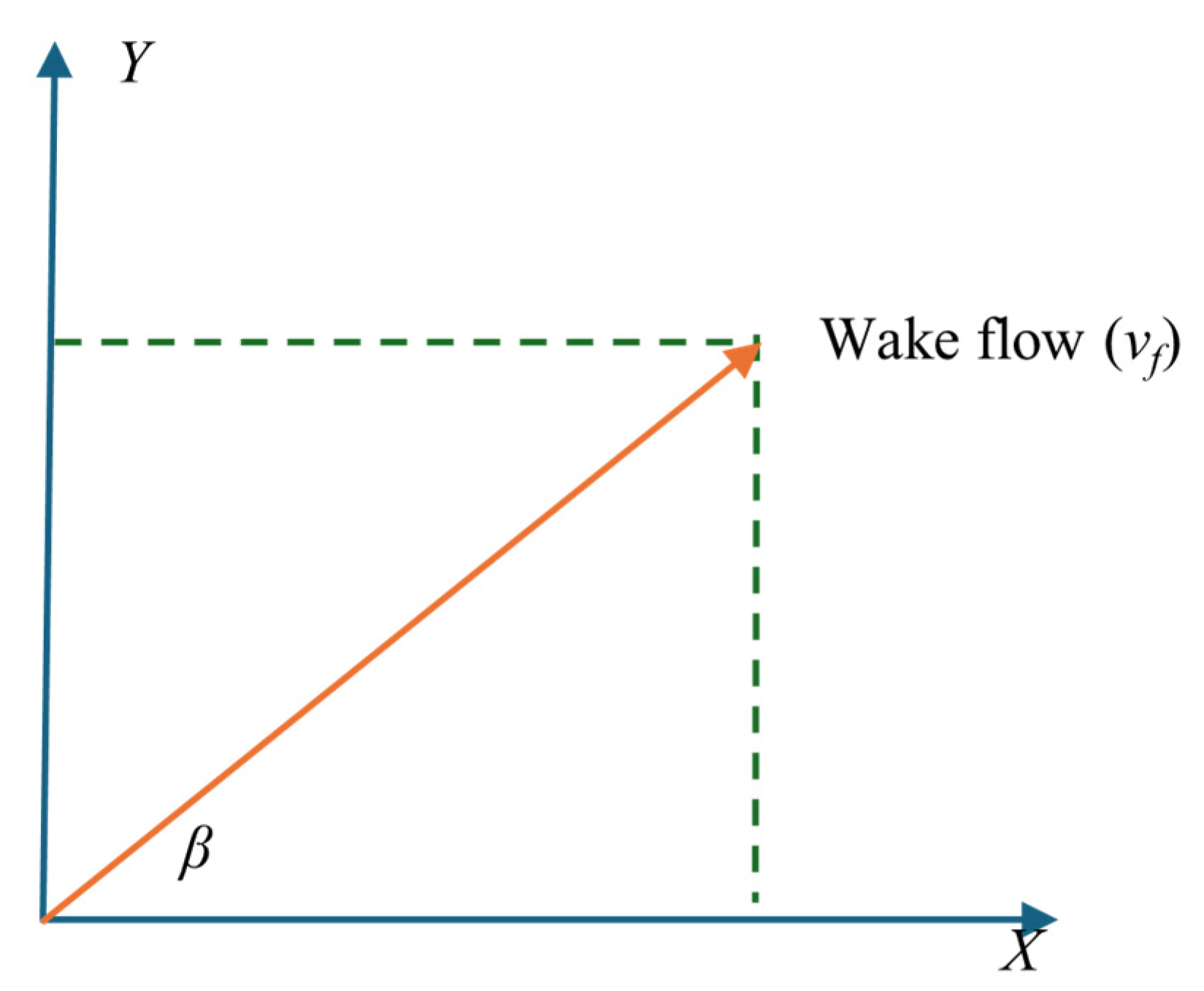
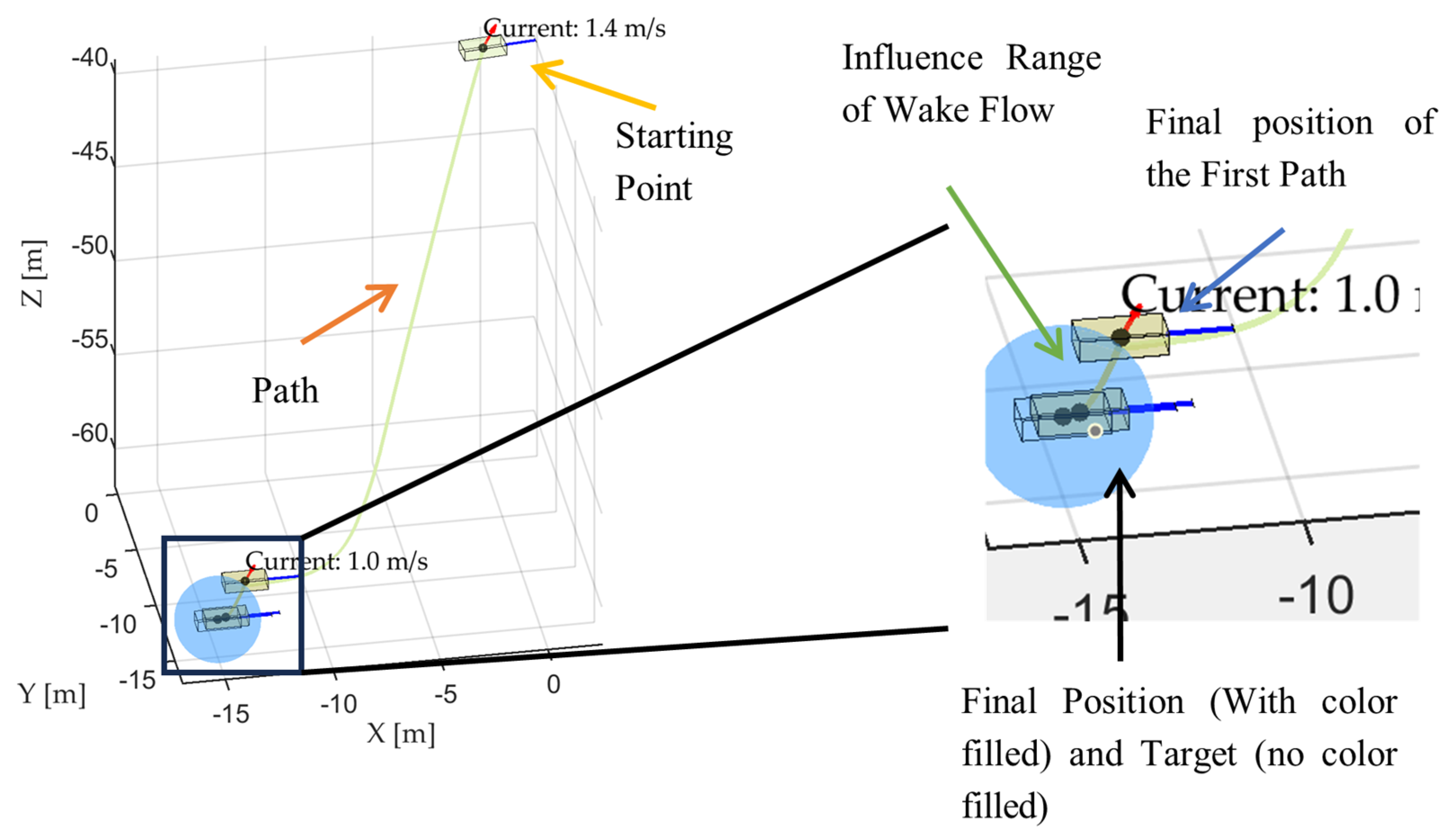

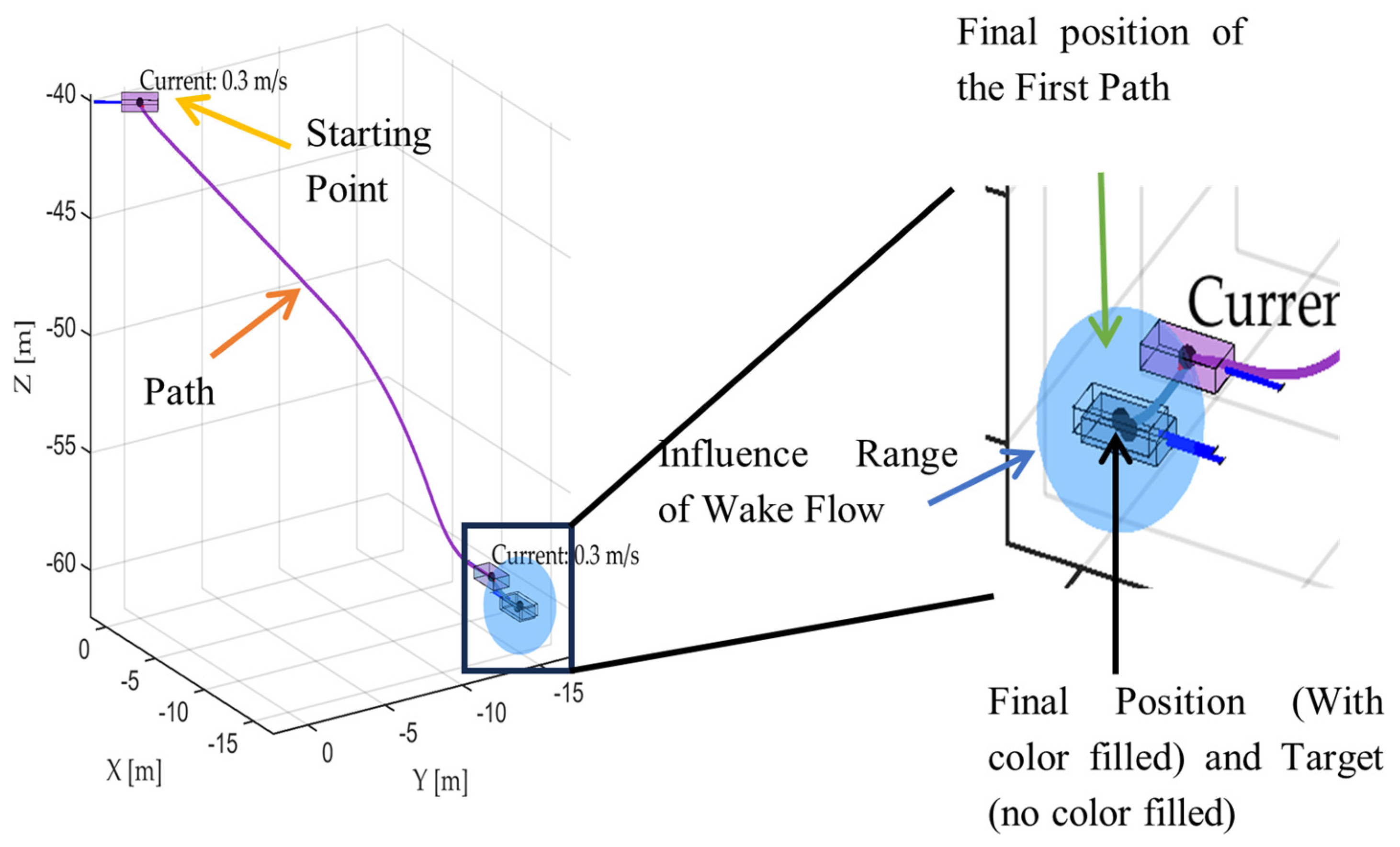

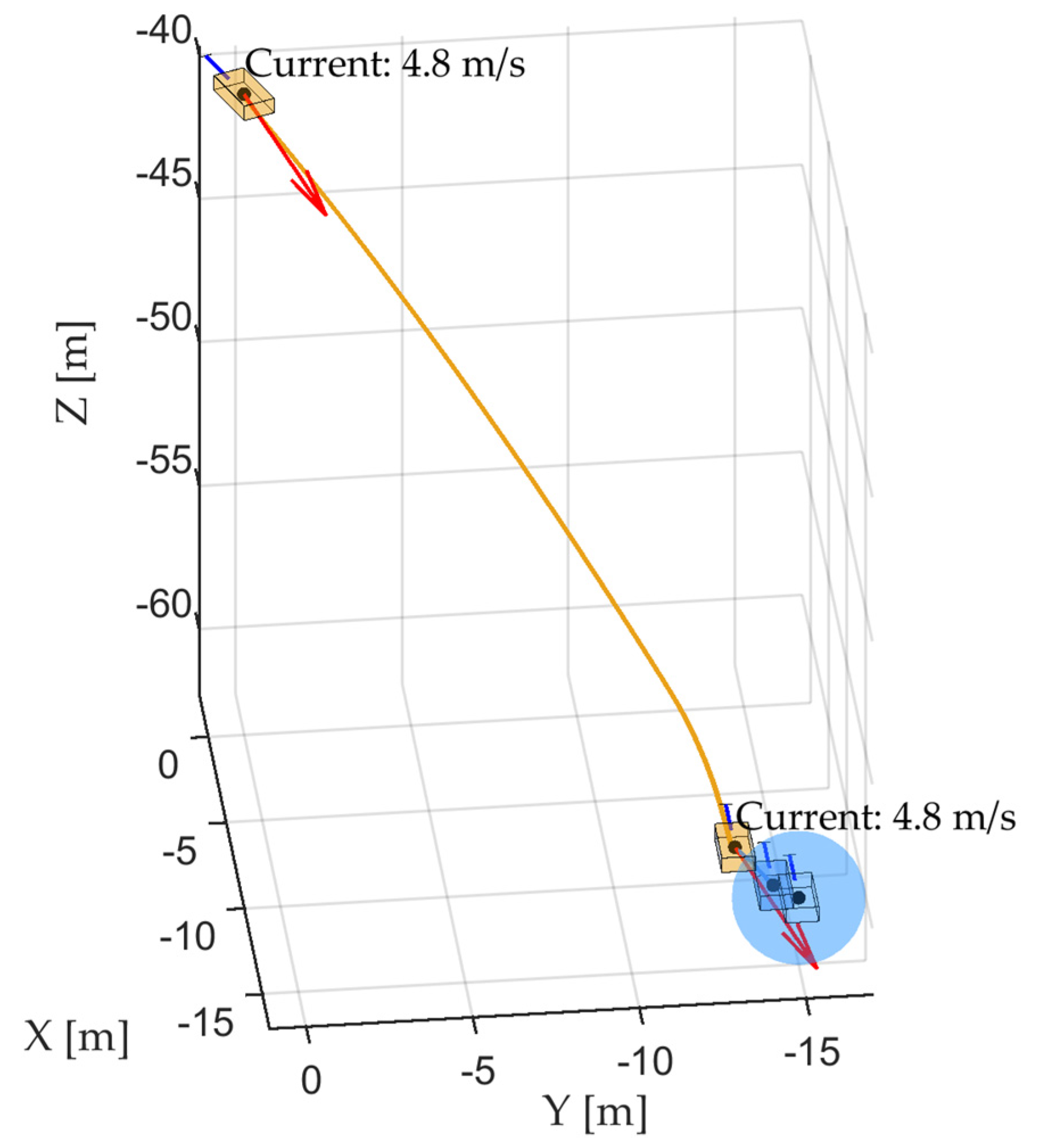
| Scenario | Start Point | Final Position | Distance (m) | Error (‰) |
|---|---|---|---|---|
| facing directly toward the current | [0, 0, −40] | [−14.8114, −14.5905, −60.039] | 0.4525 | 15‰ |
| side-on to the current | [−14.6195, −14.4217, −60.0334] | 0.8221 | 28‰ | |
| facing away from the current | [−14.9869, −14.7836, 60.148] | 0.3805 | 13‰ |
Disclaimer/Publisher’s Note: The statements, opinions and data contained in all publications are solely those of the individual author(s) and contributor(s) and not of MDPI and/or the editor(s). MDPI and/or the editor(s) disclaim responsibility for any injury to people or property resulting from any ideas, methods, instructions or products referred to in the content. |
© 2025 by the authors. Published by MDPI on behalf of the International Institute of Knowledge Innovation and Invention. Licensee MDPI, Basel, Switzerland. This article is an open access article distributed under the terms and conditions of the Creative Commons Attribution (CC BY) license (https://creativecommons.org/licenses/by/4.0/).
Share and Cite
Zhao, Y.; Xu, S.; Zheng, X.; Luo, L.; Xu, B.; Xiong, C. Enhanced Real-Time Simulation of ROV Attitude and Trajectory Under Ocean Current and Wake Disturbances. Appl. Syst. Innov. 2025, 8, 75. https://doi.org/10.3390/asi8030075
Zhao Y, Xu S, Zheng X, Luo L, Xu B, Xiong C. Enhanced Real-Time Simulation of ROV Attitude and Trajectory Under Ocean Current and Wake Disturbances. Applied System Innovation. 2025; 8(3):75. https://doi.org/10.3390/asi8030075
Chicago/Turabian StyleZhao, Yujing, Shipeng Xu, Xiaoben Zheng, Lisha Luo, Boyan Xu, and Chunru Xiong. 2025. "Enhanced Real-Time Simulation of ROV Attitude and Trajectory Under Ocean Current and Wake Disturbances" Applied System Innovation 8, no. 3: 75. https://doi.org/10.3390/asi8030075
APA StyleZhao, Y., Xu, S., Zheng, X., Luo, L., Xu, B., & Xiong, C. (2025). Enhanced Real-Time Simulation of ROV Attitude and Trajectory Under Ocean Current and Wake Disturbances. Applied System Innovation, 8(3), 75. https://doi.org/10.3390/asi8030075





